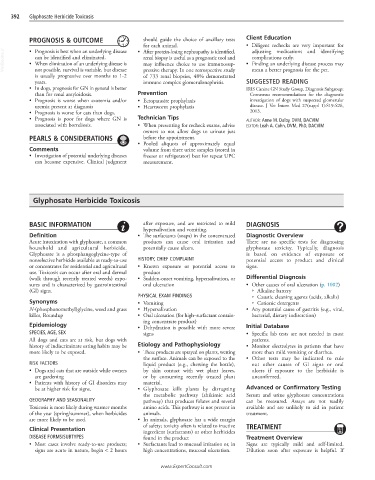Page 824 - Cote clinical veterinary advisor dogs and cats 4th
P. 824
392 Glyphosate Herbicide Toxicosis
PROGNOSIS & OUTCOME should guide the choice of ancillary tests Client Education
for each animal. • Diligent rechecks are very important for
adjusting medications and identifying
VetBooks.ir • When elimination of an underlying disease is renal biopsy is useful as a prognostic tool and • Finding an underlying disease process may
• Prognosis is best when an underlying disease
• After protein-losing nephropathy is identified,
can be identified and eliminated.
complications early.
may influence choice to use immunosup-
not possible, survival is variable, but disease
is usually progressive over months to 1-2 pressive therapy. In one retrospective study mean a better prognosis for the pet.
of 733 renal biopsies, 48% demonstrated
years. immune complex glomerulonephritis. SUGGESTED READING
• In dogs, prognosis for GN in general is better IRIS Canine GN Study Group, Diagnosis Subgroup:
than for renal amyloidosis. Prevention Consensus recommendations for the diagnostic
• Prognosis is worse when azotemia and/or • Ectoparasite prophylaxis investigation of dogs with suspected glomerular
uremia present at diagnosis • Heartworm prophylaxis disease. J Vet Intern Med 27(suppl 1):S19-S26,
• Prognosis is worse for cats than dogs. 2013.
• Prognosis is poor for dogs where GN is Technician Tips AUTHOR: Anne M. Dalby, DVM, DACVIM
associated with borreliosis. • When presenting for recheck exams, advise EDITOR: Leah A. Cohn, DVM, PhD, DACVIM
owners to not allow dogs to urinate just
PEARLS & CONSIDERATIONS before the appointment.
• Pooled aliquots of approximately equal
Comments volume from three urine samples (stored in
• Investigation of potential underlying diseases freezer or refrigerator) best for repeat UPC
can become expensive. Clinical judgment measurement.
Glyphosate Herbicide Toxicosis
BASIC INFORMATION after exposure, and are restricted to mild DIAGNOSIS
hypersalivation and vomiting.
Definition • The surfactants (soaps) in the concentrated Diagnostic Overview
Acute intoxication with glyphosate, a common products can cause oral irritation and There are no specific tests for diagnosing
household and agricultural herbicide. potentially cause ulcers. glyphosate toxicity. Typically, diagnosis
Glyphosate is a phosphangoglycine-type of is based on evidence of exposure or
nonselective herbicide available as ready-to-use HISTORY, CHIEF COMPLAINT potential access to product and clinical
or concentrates for residential and agricultural • Known exposure or potential access to signs.
use. Toxicosis can occur after oral and dermal product
(walk through recently treated weeds) expo- • Sudden-onset vomiting, hypersalivation, or Differential Diagnosis
sures and is characterized by gastrointestinal oral ulceration • Other causes of oral ulceration (p. 1002)
(GI) signs. ○ Alkaline battery
PHYSICAL EXAM FINDINGS ○ Caustic cleaning agents (acids, alkalis)
Synonyms • Vomiting ○ Cationic detergents
N-(phosphonomethyl)glycine, weed and grass • Hypersalivation • Any potential cause of gastritis (e.g., viral,
killer, Roundup • Oral ulceration (for high–surfactant contain- bacterial, dietary indiscretion)
ing concentrate product)
Epidemiology • Dehydration is possible with more severe Initial Database
SPECIES, AGE, SEX signs • Specific lab tests are not needed in most
All dogs and cats are at risk, but dogs with patients.
history of indiscriminate eating habits may be Etiology and Pathophysiology • Monitor electrolytes in patients that have
more likely to be exposed. • These products are sprayed on plants, wetting more than mild vomiting or diarrhea.
the surface. Animals can be exposed to the • Other tests may be indicated to rule
RISK FACTORS liquid product (e.g., chewing the bottle), out other causes of GI signs or oral
• Dogs and cats that are outside while owners by skin contact with wet plant leaves, ulcers if exposure to the herbicide is
are gardening or by consuming recently treated plant unconfirmed.
• Patients with history of GI disorders may material.
be at higher risk for signs. • Glyphosate kills plants by disrupting Advanced or Confirmatory Testing
the metabolic pathway (shikimic acid Serum and urine glyphosate concentrations
GEOGRAPHY AND SEASONALITY pathway) that produces folates and several can be measured. Assays are not readily
Toxicosis is more likely during warmer months amino acids. This pathway is not present in available and are unlikely to aid in patient
of the year (spring/summer), when herbicides animals. treatment.
are more likely to be used. • In animals, glyphosate has a wide margin
of safety; toxicity often is related to inactive TREATMENT
Clinical Presentation ingredient (surfactants) or other herbicides
DISEASE FORMS/SUBTYPES found in the product Treatment Overview
• Most cases involve ready-to-use products; • Surfactants lead to mucosal irritation or, in Signs are typically mild and self-limited.
signs are acute in nature, begin < 2 hours high concentrations, mucosal ulceration. Dilution soon after exposure is helpful. If
www.ExpertConsult.com

